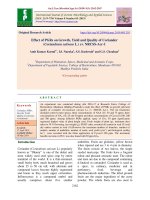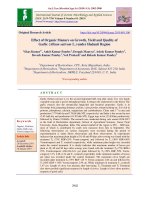Effect of potassium on growth, yield and quality of groundnut (Arachis hypogaea L.) grown in loamy sand soil
Bạn đang xem bản rút gọn của tài liệu. Xem và tải ngay bản đầy đủ của tài liệu tại đây (410.28 KB, 9 trang )
Int.J.Curr.Microbiol.App.Sci (2019) 8(9): 2723-2731
International Journal of Current Microbiology and Applied Sciences
ISSN: 2319-7706 Volume 8 Number 09 (2019)
Journal homepage:
Original Research Article
/>
Effect of Potassium on Growth, Yield and Quality of
Groundnut (Arachis hypogaea L.) Grown in Loamy Sand Soil
P. B. Chaudhary, S. K. Shah*, M. G. Chaudhary, J. K. Patel and K.V. Chaudhary
Castor Mustard Research Station, S. D. Agricultural University, Sardarkrushinagar-385 506,
Distt. Banaskantha (Gujarat) India
*Corresponding author
ABSTRACT
Keywords
Groundnut,
Potassium, KSB,
NPK consortium
and Fatty acid
Article Info
Accepted:
24 August 2019
Available Online:
10 September 2019
A field experiment entitled, “Effect of Potassium on Growth, Yield and Quality of
Groundnut (Arachis hypogaea L.) grown in loamy sand soil” was carried out at Castor Mustard Research Station, Sardarkrushinagar Dantiwada Agricultural University,
Sardarkrushinagar during summer2017. The soil of the experimental field was loamy sand
in texture; neutral in reaction (pH- 7.2) and electrical conductivity (EC- 0.1 dSm-1); low in
both organic carbon (0.2 %) and available N (156 kg/ha); medium in both available P 2O5
(44.2 kg/ha) and available K2O (256 kg/ha).Total ten treatments namely,T1: RDF
(25:50:00 kg/ha),T 2 : RDF + KSB, T3 : RDF + 20 kg K2O,T4 : RDF + 40 kg K2O, T5: RDF
+ 15 kg K2O + KSB, T6 : RDF + 30 kg K2O + KSB, T7: 75 % RDF + NPK consortium,
T8:NPK consortium, T9 : RDF + NPK consortium and T 10 : Absolute control were
evaluated in randomised block design with three replications with groundnut variety GG 2
as a test crop.Almost all the growth and yield parameters of groundnut viz., plant height at
harvest (58.3 cm), number of pod per plant (29.3), pod yield (2872 kg/ha) and haulm yield
(4274kg/ha) were recorded significantly higher with application of RDF + NPK
consortium (T9) over the rest of the treatments. With regards to oil content of groundnut
application of RDF + NPK consortium (T9) gave significant impact on increment of oil
content in kernel (48.35 %). However, the fatty acid profile (%) of groundnut oil was not
affected significantly due to different treatments. Higher benefit: cost ratio of 3.70 was
observed with treatment RDF + NPK consortium (T 9).
Introduction
Groundnut (Arachis hypogaea L.) contains
high quality edible oil (48 per cent), easily
digestible protein (26 per cent) and
carbohydrates (20 per cent) therefore
considered as „king of oilseed‟ among the
oilseed crops and botanically classified in
family Fabaceae (Das et al., 2005).Groundnut
provides an inexpensive source of high quality
dietary protein and oil to millions of people in
world especially in developing counties also it
is a source of considerable amounts of mineral
elements to supplement the dietary
requirements of humans and farm animals.
(Asibuo et al., 2008).Peanut oil like other
vegetable oil is determined on the ester which
is made up of straight chain higher fatty acids
2723
Int.J.Curr.Microbiol.App.Sci (2019) 8(9): 2723-2731
and glycerine. The fatty acids include the
unsaturated; palmitic acid and stearic acid,
mono unsaturated fatty acids; such as oleic
acid, and polyunsaturated fatty acids such as
linoleic acid, linolenic acid.
As per estimate, groundnut is grown in India
on 4.56 million hectare and production of 6.77
million tonnes with an average productivity of
1486 kg/ha (DAC and FW, 2016). In India,
about 80 per cent of the area and 84 per cent
of the production of groundnut is confined to
the states of Gujarat, Andhra Pradesh, Tamil
Nadu, Karnataka and Maharashtra. However,
it is also grown in Uttar Pradesh, Tamil Nadu,
Punjab and west Bengal. Among the ground
nut producing states, Gujarat is the topmost
state both in area and production.
Within Gujarat, the Saurashtra region is
considered as „bowl of groundnut‟. It has been
witnessed that the area under groundnut is also
increasing in potato growing areas of North
Gujarat considerably because of suitable agroclimatic conditions and coarse texture soil.
The agricultural soils are over exploited for
available plant nutrients when fertilized
injudiciously under continuous farming
(Marinari et al., 2000). The new epicenter for
groundnut crop in light textured potato soils of
North Gujarat has no exception.
These soils are low in nutrients and responsive
to the applied fertilizers even of potassium.
Plants need large quantities of potassium, as
much as, or even more than nitrogen.
Potassium improves economic crop produce
and its quality(Singh, 2007).Potassium is
considered one of the primary nutrients
responsible for quality of groundnut crop
(Sanadi et al., 208). Long term fertilizer
experiments confirm the need of potassium
fertilization in the soils of Gujarat (Malavia et
al., 1999). Bio-fertilizers can play an
important role in meeting the nutrient
requirement of crops. Plant growth promoting
bacteria (PGPR) are a group of free living
microorganisms that use different methods to
increase plant growth (Glick and Bashan,
1997). Farmer is well acquainted with the use
of rhizobium biofertilizer in groundnut.
Use of PSB is also gaining momentum among
the farmers. Use of Potassium Solubilizing
Bacteria (KSB) is not much popular among
the groundnut farmers. Moreover, the research
on use of KSB in groundnut is also very
scanty.
Materials and Methods
The field experiment was carried out during
summer 2017 at Castor - Mustard Research
Station,
S.D.
AgriculturalUniversity,
Sardarkrushinagar, Banaskantha (Gujarat,
India) located at 72o 19' East longitude and
24o19' North latitude at 154.52 meters above
the mean sea level. The region falls under
North Gujarat Agro-Climatic Zone (AES-IV)
of Gujarat (Fig 1).
The soil of the experimental field was loamy
sand in texture; neutral in reaction (pH 7.2)
and electrical conductivity (EC 0.1 dSm-1);
low in both organic carbon (0.2 %) and
available N (156 kg/ha); medium in both
available P2O5 (44.2 kg/ha) and available K2O
(256 kg/ha). Groundnut variety GG 2 was
evaluation under ten treatments namely,T1:
RDF (25:50:00 kg/ha),T2 : RDF + KSB, T3 :
RDF + 20 kg K2O,T4 : RDF + 40 kg K2O, T5:
RDF + 15 kg K2O + KSB, T6 : RDF + 30 kg
K2O + KSB, T7: 75 % RDF + NPK
consortium, T8:NPK consortium, T9 : RDF +
NPK consortium and T10 : Absolute Control
designed in randomized block design with
three replications. Recommended dose of 25
kg N + 50 kg P2O2 ha-1 and seed treatment
with rhizobium and PSB were applied as
common dose to all the treatments except
absolute control. The source of N and P2O5
2724
Int.J.Curr.Microbiol.App.Sci (2019) 8(9): 2723-2731
were Urea and DAP, respectively. Potassium
was applied as MOP. KSB and NPK
consortium were applied as seed treatment at
time of sowing in respective treatments.
Groundnut cv. GG2 was sown with
recommended seed rate of 120 kg/ha by
maintaining 30 cm distance between two
rows. The seeds were sown manually at about
the depth of 5 cm in previously opened
furrows and covered properly with the soil.
All the appropriate cultural practices and
timely plant protection measures were adopted
uniformly for all the treatments.
At physiological maturity, five plants were
randomly selected from each net plot to
measure growth parameters (plant height and
number of pods per plant at harvest).
Shelling percentage (%)
Fatty acid profile of groundnut oil
Approximately 60 g dried seeds were
collected from each treatment were defatted
using Soxhlet apparatus. The oil was
converted to Fatty Acid Methyl Ester (FAME)
using alkaline catalyzed trans-esterification
using 4% KOH solution in methanol. The GC
(Thermo-Trace ultra-A1 3000 Auto sampler)
was programmed as, inlet temperature 210°C,
FID detector temperature 260°C. Oven was
kept at 160°C for 2 min. after that an increase
of 10°C/min. was applied to raise oven
temperature to 200°C, where it was kept at
isotherm for 10 min. The gas flow rate in
column was 1.5ml/min and the sample
injection volume was 0.2 µl. The capillary was
-TR fame-30 m × 0.25 mm ID × 0.25 µm film.
Fatty acids composition of each treatment
sample was estimated in percentage by using
Chromcard Software associated with GC.
A composite sample of 100 g pods was drawn
from the bulk of dry pods randomly and
shelled. The ratio of kernel weight to pod
weight was worked out and expressed in
percentage.
All the data obtained were statistically
analyzed by using the Panse and Sukhatme
(1985) procedure.
Shelling percentage (%)
Kernel weight (g)
=-------------------- × 100
Pod weight (g)
Effect on growth parameter
Protein content (%)
The groundnut oil seeds were made defatted
on soxhlet and the protein content was by
Kjeldahl method (AOAC, 2000).
Oil content in kernel (%)
The oil content was determined in percentage
by using Bench top Nuclear Magnetic
Resonance (NMR) Oxford MQC using the
method as suggested by Yadav and Murthy
(2016).
Results and Discussion
A perusal of data exhibited in Table 1
indicated that plant population per net plot at
harvest was not significantly influenced due to
different treatments. Plant height was
measured at harvest in different treatments and
the data indicated that significantly taller
plants (58.3 cm) were observed with treatment
RDF + NPK consortium (T9) over
control(T10). Plant height under treatment
RDF + NPK consortium (T9) was at par with
all other treatments except NPK consortium
(T8).This might be due to adequate supply of
nutrients required for optimum growth and
development of groundnut plants under
different treatments. Microbial secretion of
organic acid might helped in improving soil
2725
Int.J.Curr.Microbiol.App.Sci (2019) 8(9): 2723-2731
conditions
required
for
better
root
proliferation. Better availability of nutrients
like nitrogen, phosphorus and potassium at
early stages which in turn helped in better
absorption and subsequent utilization of
nutrients for synthesis of biomolecules,
protein metabolism leading to more plant
height. These results are in accordance with
the findings of Der et al., (2015).
Number of pods per plant was significantly
higher with treatment RDF +NPK consortium
(T9) over control (T10)and it was at par with
the treatment RDF + 30 kg K2O + KSB
(T6)and 75 % RDF + NPK consortium (T7)
over control T10.
This might be due to improvement in
vegetative structures for nutrient absorption
and photosynthesis, strong sink strength
through
development
of
reproductive
structures and production of assimilates under
the influence of applied NPK consortium as
well as KSB and other microorganisms. These
results are in accordance with the findings of
Chaudhary et al., (2015).
Pod yield, haulm yield and harvest index
(%)
Pod yield increased significantly under the
treatment of NPK consortium in conjunction
with RDF. Significantly higher pod yield
(2872 kg/ha) of groundnut was produced
under the treatment RDF + NPK consortium
(T9) as compared to rest of the treatments, but
it remained at par with the treatment RDF +
30 kg K2O + KSB (T6)and 75 % RDF + NPK
consortium (T7).
Further, pronounced effect of NPK consortium
on pod yield might be due to its ability to fix
nitrogen, mobilize phosphorus and potassium
as well as other beneficial hormones, enzymes
and siderophores which might have helped in
better nutrient uptake, optimum growth and
higher yield. These results are in accordance
with the findings of Chandra et al., (2006).
Application of RDF + NPK consortium (T9)
registered significantly higher haulm yield
(4274 kg/ha) over all other treatments (Table
2), but it was found at par with treatment T4
(3761kg/ha), T5 (3620kg/ha), T6 (3914kg/ha)
and T7 (4050kg/ha). The treatments
T9,T7,T6,T5and T4 gave 41.66, 34.23, 29.73,
19.98 and 24.85 per cent higher haulm yield,
respectively as compared to treatmentT10.
Better growth environment created by
microorganisms might be one of the most
probable reasons for significantly higher
haulm yield under treatment T9,T7,T6,T5and
T4. Kulkarni et al.,(2018) found similar results
in groundnut.
The higher haulm yield in groundnut crop was
attributed to the beneficial effect of readily
available forms of nutrients to the crop which
were supplied through foliar spray. These
nutrients were directly absorbed by plant
either through cuticle or stomata and might
have participated in photosynthesis activity in
leaves of plant leading to increased haulm
yield.
Foliar spray of nutrients to the crop resulted in
timely supply of optimum quantity of nutrients
to the plant and their subsequent absorption by
groundnut leaves resulting in better
assimilation and translocation of nutrients
(Mekki, 2015). Different treatments did not
exert any significant effect on the harvest
index.
Shelling percentage
The maximum shelling percentage of
groundnut was noted under the treatment of 15
kg K2O+KSB in conjunction with RDF(T5)
which was at par with the treatment T1, T2, T3,
T4, T6 andT7. Further, noticeable effect KSB
on shelling percentage might be due to its
2726
Int.J.Curr.Microbiol.App.Sci (2019) 8(9): 2723-2731
ability to solubilize potassium as well as other
hormones, enzymes and siderophores which
might have helped in better potassium uptake,
optimum growth and higher shelling
percentage. These results are in accordance
with the findings of Hemeid et al., (2015).
Table.1 Growth and yield attributes of groundnut at harvest as influenced by different treatments
Treatments
T1 : RDF (25 : 50 : 00 kg/ha)
T2 : RDF + KSB
T3 : RDF + 20 kg K2O
T4 : RDF + 40 kg K2O
T5 : RDF + 15 kg K2O + KSB
T6 : RDF + 30 kg K2O + KSB
T7 : 75 % RDF + NPK consortium
T8 : NPK consortium
T9 : RDF + NPK consortium
T10 : Absolute control
S.Em. ±
C.D. at 5 %
C.V. %
Plant population
Plant
(cm)
161
159
162
160
163
161
164
159
165
160
3.70
NS
3.97
50.0
52.0
54.3
54.3
54.7
53.7
57.0
49.7
58.3
42.7
2.77
8.24
9.13
height Number of
pod
per
plant
24.0
24.3
25.0
26.0
25.7
27.0
28.3
23.7
29.3
22.7
1.09
3.25
7.4
Table.2 Pod yield, haulm yield, harvest index, kernel oil content and shelling percentage of
groundnut as influenced by different treatments
Treatments
T1
: RDF (25:50:00 kg/ha)
T2
: RDF + KSB
T3
: RDF + 20 kg K2O
T4
: RDF + 40 kg K2O
T5
: RDF + 15 kg K2O + KSB
T6
: RDF + 30 kg K2O + KSB
T7
: 75 % RDF + NPK consortium
T8
: NPK consortium
T9
: RDF + NPK consortium
T10 : Absolute control
S.Em. ±
C.D. at 5 %
C.V. %
Pod
yield
(kg/ha)
2215
2236
2284
2369
2337
2435
2529
2128
2872
1904
163.56
485.95
12.15
2727
Haulm
yield
(kg/ha)
3384
3414
3501
3761
3620
3914
4050
3271
4274
3017
243.10
722.30
11.63
Harvest
index
(%)
39.38
39.60
39.63
38.73
39.34
38.52
38.58
39.61
40.28
38.62
2.57
NS
11.36
Shelling
(%)
67.07
67.20
68.67
68.03
69.23
68.23
69.10
63.17
68.80
59.30
2.03
6.04
5.27
Int.J.Curr.Microbiol.App.Sci (2019) 8(9): 2723-2731
Table.3 Kernel oil content and protein content of groundnut as influenced by different treatments
Treatments
RDF (25:50:00 kg/ha)
RDF + KSB
RDF + 20 kg K2O
RDF + 40 kg K2O
RDF + 15 kg K2O + KSB
RDF + 30 kg K2O + KSB
75 % RDF + NPK consortium
NPK consortium
RDF + NPK consortium
Absolute control
T1
:
T2
:
T3
:
T4
:
T5
:
T6
:
T7
:
T8
:
T9
:
T10
:
S.Em. ±
C.D. at 5 %
C.V. %
Kernel oil
(%)
47.30
47.39
48.23
48.18
48.25
48.17
48.31
46.41
48.35
45.42
0.60
1.77
2.17
Protein content
(%)
21.63
21.73
22.19
23.00
22.63
23.06
23.13
21.13
23.23
20.25
0.608
1.82
4.74
Treatments
Fatty acid profile
Palmitic
Steric
Oleic
Linoleic
Linolenic
Arochidic
Gadoleic
Behenic
Lignoceric
Table.4 Fatty acid profile (%) of groundnut as influenced by different treatments
T1:RDF (25 : 50 :
00 kg/ha)
T2:RDF + KSB
T3:RDF +
20 kg K2O
T4:RDF +
40 kg K2O
T5:RDF +
15 kg K2O + KSB
T6:RDF +
30 kg K2O + KSB
T7:75 % RDF +
NPK consortium
T8:NPK
consortium
T9:RDF + NPK
consortium
T10:Absolute
control
S.Em.±
C.D. at 5%
C.V.%
13.14
3.40
41.16
34.87
1.33
0.78
2.56
1.13
0.46
13.27
12.79
3.34
3.53
41.42
41.42
35.46
35.92
1.25
1.33
0.74
0.81
2.56
2.34
1.10
1.14
0.38
0.41
13.45
3.22
41.46
36.57
1.36
0.73
2.39
1.19
0.43
13.36
3.24
40.96
35.41
1.34
0.76
2.32
1.14
0.46
13.60
3.48
41.48
36.22
1.42
0.76
2.65
1.14
0.45
13.26
3.82
41.69
34.43
1.45
0.76
2.59
1.12
0.43
13.54
3.23
41.68
36.83
1.14
0.74
2.11
1.15
0.43
13.47
3.15
41.57
36.71
1.16
0.72
2.24
1.24
0.47
12.77
3.13
40.74
36.78
1.35
0.70
2.59
1.08
0.46
0.33
NS
4.31
0.17
NS
8.72
0.83
NS
3.46
0.93
NS
4.50
0.07
NS
9.66
0.03
NS
7.07
0.12
NS
8.66
0.04
NS
5.62
0.02
NS
7.34
2728
Int.J.Curr.Microbiol.App.Sci (2019) 8(9): 2723-2731
Fig.1 Geographical location of Dantiwada in Gujarat (India)
2729
Int.J.Curr.Microbiol.App.Sci (2019) 8(9): 2723-2731
Oil and Protein content
Oil and protein contents of groundnut were
significantly influenced by different potassium
treatments (Table 3). Significantly higher oil
content (48.35%) of groundnut was recorded
under the treatment RDF + NPK consortium
(T9) over control (T10) but it remained at par
with the rest of the treatments except NPK
consortium (T8). The increase in oil content in
groundnut kernels might be due to the
enhanced activity of malic dehydrogenase
enzyme which helps in the synthesis of fatty
acids such as malate and oxaloacetate in
groundnut, resulting in the enhanced oil
content. These results are in accordance with
the findings of Sanadi et al., (2018).
Data presented in Table 3 revealed that
different treatments highest protein content
was found in treatment T9 which was at par
with all the treatments except treatment T8 and
T10. Addition of nutrients through chemical
fertilizer increased the protein content in
groundnut kernel and was attributed to the role
of potassium in facilitating the uptake as well
as assimilation of nitrogen into simple amino
acids and amides which enhanced the peptide
synthesis and led to protein synthesis (Umar
and Moinuddin, 2002).
Fatty acid profile
Under the present study, different treatments
failed to exert significant response on fatty
acid profile per cent in oil (Table 4).The main
saturated fatty acids present in groundnut oil
were palmitic acid 13.26 per cent and steric
acid 3.35per cent. The groundnut contained
41.36 per cent of oleic acid, which was
monounsaturated fatty acid, 35.92 per cent
linoleic acid and 1.31per cent linolenic acid
which were key polyunsaturated fatty acids of
groundnut oil. The increase in oil content in
groundnut kernels might be due to the
enhanced activity of malic dehydrogenase
enzyme, which helps in the synthesis of fatty
acids such as malate and oxaloacetate in
groundnut kernels thus, resulting in the
enhanced oil content. These results are in
accordance with the findings of Dwivedi et
al., (1993) and Sanadi et al., (2018).
Economics
Under the present study, the higher net
realization of Rs 111063/ha was accrued with
the treatment T9 (RDF + NPK consortium), it
was followed by treatment T7 (Rs 94043/ha).
The lowest net realization (Rs62872/ha) was
noticed under the treatment T10 (Absolute
control). Higher benefit: cost ratio of 3.70 was
observed with treatment T9 (RDF + NPK
consortium) and followed by treatment T7
(3.32). The lowest benefit: cost ratio of 2.64
was noted with the treatment T10 (Absolute
control) (Fig 2). This could be attributed to
higher pod and haulm yield received in these
treatments.
Therefore it can be inferred that from the
foregoing results and discussion that
significant increase in yield, oil content and
protein content due to potassium application
either in form of chemical fertilizer or
potassium solubilizing bacteria. Considering
benefit cost ratio, it seems that recommended
dose of fertilizer along with microbial
consortium (NPK) may be a better
combination for sustainable groundnut
production.
References
AOAC
(2000).Official
method
analysis.Association of official chemist,
Washington DC.
Chandra P, Samui RC and Sanjoy KB2006.
Growth, yield attributes and yield of different
cultivars of groundnut as affected by
potassium application. Journal of Crop and
Weed.2: 37-39.
ChaudharyJH, RamdevSutaliya and Desai L. J.
2730
Int.J.Curr.Microbiol.App.Sci (2019) 8(9): 2723-2731
2015.Growth, yield, yield attributes and
economics
of
summer
groundnut
(Arachishypogaea L.) as influenced by
integrated nutrient management. Journal of
Applied and Natural Science 7 (1) : 369 –
372.
DAC and FW 2016. All India Area, Production
and Yield in groundnut. Directorateof
Economics and Statistics, Agricultural
Statistics at a Glance, 2016.
Das, P., Laishram, P.D. and Gogoi, M. (2005).
Nutrient composition of some nuts and oil
seeds based recipes of Assam. India. J. Hum.
Ecol., 18 (2): 161-165.
Der HN, Vaghasia PM and Verma HP 2015.Effect
of foliar application of potash and
micronutrients on growth and yield attributes
of groundnut. Annals of Agricultural
Research.New Series. 36: 275-278.
Glick, BR and Bashan, Y. 1997. Genetic
manipulation of plant growth promoting
bacteria
to
enhance
biocontrol
of
phytopathogens.Biotechnol. Adv., 15: 353-78.
Hemeid, NM2015. Effect of different sources and
levels of potassium fertilization on
productivity of peanut grown under sandy soil
conditions.Journal of Soil Science and
Agricultural
Engineering,
Mansoura
University. 6: 1441-1454.
Kulkarni MV, Patel KC, Patil DD and
MadhuriPathak 2018.Effect of organic and
inorganic fertilizers on yield and yield
attributes of groundnut and wheat.
International Journal of Chemical Studies. 6:
87-90.
MalaviaDD, ModhavadiyaMM, Gundalia JD,
Dudhatra MJ, Golakiya BA, Asodaria KB,
Vyas, MN and Hadvani GJ 1999. Research
Highlights of LTFE. pp. 11-25, Gujarat
Agricultural University, Junagadh.
Marinari, S., Masciandaro, G. and Grego, S.
(2000). Influence of organic and mineral
fertilizers on soil biological and physical
properties. Bioresource Technology, 13171320
Panse, V.G. and Sukhatme.P.V. (1985).Statistical
methods for agricultural workers. ICAR Pub.
New Delhi, pp: 296.
Sanadi U, Math KK, Bidari, BI and Yenagi, BS
2018. Effect of potassium nutrition on yield,
quality
and
economics
in
groundnut(ArachishypogaeaL.) in a Vertisol.
Journal
of
Pharmacognosy
and
Phytochemistry.7: 220-222.
SanadiUmmesalma, MathKK, Bidari BI and
YenagiBS. 2018.Effect of potassium nutrition
on yield, quality and economics in groundnut
(Arachishpogaea L.) in a Vertisol. Journal of
Pharmacognosy and Phytochemistry.7 : 220222
Singh RA. Effect of variable doses of potassium,
sulphur and calcium on pod yield of short
duration
summer
groundnut
(Arachishypogaea L.). Int. J. Agric. Sci. 2007;
3(1):196-198.
Umar S, Moinuddin. Genotypic differences in
yield and quality of groundnut as affected by
potassium nutrition under erratic rainfall
conditions. J. Plant Nutr. 2002; 25(7):15491562.
Asibuo, J.Y, Akromah, R, Safo-Kantanka, O.O
sei,AduDapaah, Hanskofi, O.S and Agyeman,
A.
(2008).Chemical
Composition
of
Groundnut,
Arachishypogaea(L)landraces.
African Journal of Biotechnology.Vol,
7(13),pp: 2203-2208.
Dwivedi SL, Nigam SN Jambunathan R,
Sahrawat, KL, Nagabhushanam, GVS and
Raghunath K 1993. Effect of Genotypes and
Environments on Oil Content and Oil Quality
Parameters and Their Correlation in Peanut
(Arachishypogaea L,)Peanut Science (1993)
20:84-89.
How to cite this article:
Chaudhary, P. B., S. K. Shah, M. G. Chaudhary, J. K. Patel and Chaudhary, K.V. 2019. Effect
of Potassium on Growth, Yield and Quality of Groundnut (Arachis hypogaea L.) Grown in
Loamy Sand Soil. Int.J.Curr.Microbiol.App.Sci. 8(09): 2723-2731.
doi: />2731

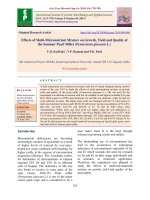
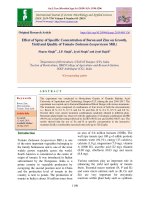
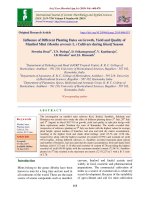
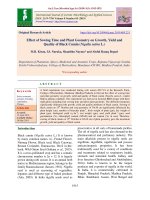
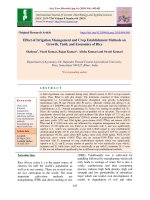
![Effect of fertility levels and stress mitigating chemicals on nutrient uptake, yield and quality of mungbean [Vigna radiata (L.) Wilczek] under loamy sand soil of Rajasthan](https://media.store123doc.com/images/document/2020_01/09/medium_ftp1578562755.jpg)
